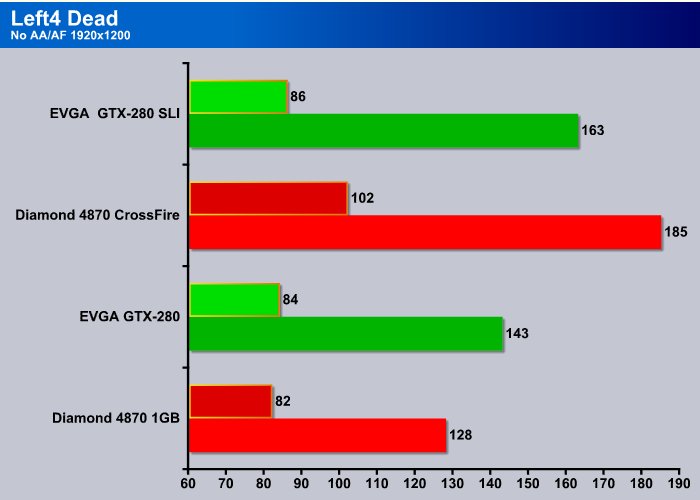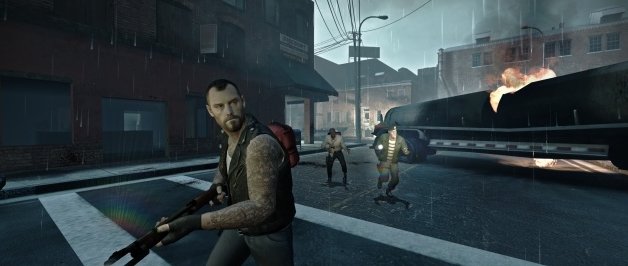Left4Dead is a new FPS that revives the FPS Horror genre but will it do well in SLI and CrossFire? We grabbed 2 EVGA GTX-280’s and 2 Diamond 4870 1GB and rushed to our rig…
Left 4 Dead Evga GTX-280 SLI, Diamond 4870 1GB CF Performance Review
Left 4 Dead, a revival of the FPS Horror Genre, was released on November 18th 2008, published by Valve and much to our surprise, was a DX9 game. The single player game consists of four levels where you’re trying to reach a destination and get rescued. Each of the four levels has its own rescue point. While making your way to the rescue points you’ll encounter hordes of Zombies, the occasional Boomer, solitary Hunters, occasional Zombie Witches, choking Smokers, and the dreaded Tank. Each has its own strategy, and their AI allows them to attack in different ways. While Zombie AI is what you’d expect from the recently dead returned to life, Boomers and Hunters have a more refined AI that allows for some strategy.
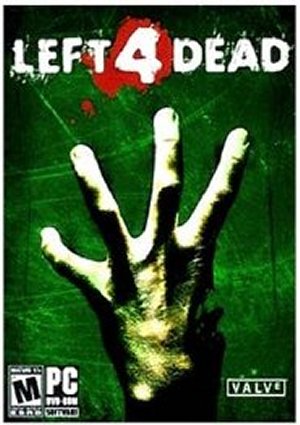
Boomers in particular are particularly annoying if you shoot one too close to you. They spew a green slime that covers you and attracts “The Horde”. When The Horde is attracted you’re literally swamped with masses of Zombies trying to do what they do best, kill you and eat your brains.
Tanks are hard to kill. They’re Boss type creatures that dwarf the normal Zombies (if there is such a thing as normal Zombies). The best strategy we’ve found for those is a running retreat while laying down massive firepower at the Tank. Standing your ground and trying to defeat one is liable to end in massive loss of hit points.
Witches seem to lurk about crying, and then when you disturb them, they jump up and run at you but die rather easily. So far, we haven’t seen that they have any special powers, though we have had limited time for straight game play.
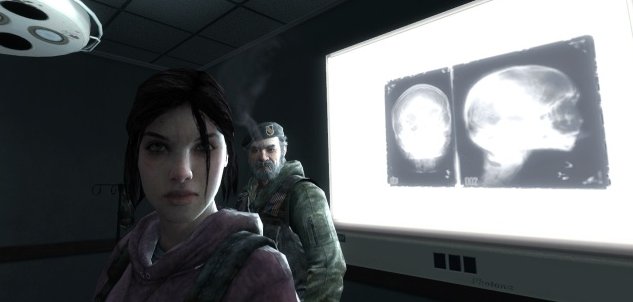
Hunters are a more intelligent Zombie that move faster and actively hunts your team. Their speed and hunting ability make them a little harder to target.
Smokers have the ability to shoot out their tongues and constrict you from long distances. While constricted by a Smoker or pinned by a Hunter your teammates will need to rescue you. If you’re really fast, occasionally, you can kill a Smoker when he first constricts you.
Ordinary Zombies just kind of hang out, letting you methodically kill them until, once in a while, they make a mad dash for you. The real fun comes when you’re splashed by Boomer slime, or you’re at a critical junction in the game and you have to fight The Horde.
Weapons and ammo don’t seem to be in short supply if you’re willing to do a little searching, and they are available in every safe house we’ve encountered along the way.
Single Player and MMORPG gaming is particularly engaging and good for the occasional Adrenalin rush. There’s nothing like burning a hundred rounds while dealing death to the dreaded undead hordes.
It doesn’t hurt to remember that the only good Zombie is a dead (re-dead) Zombie, and that they will kill you and eat your brain, so do unto them before they eat your brain.
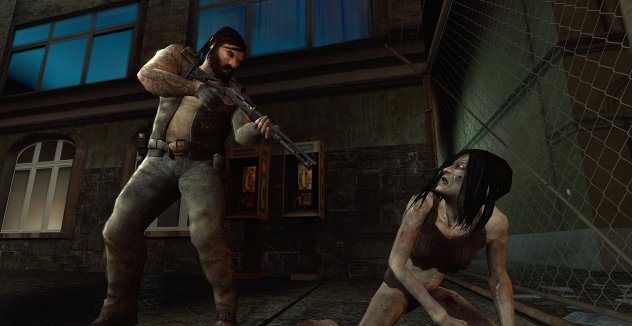
Since we have a Core i7 platform available that will run CrossFire and SLI on demand we decided to strap a couple of Diamond 4870 1GB on and run them in CrossFire, and a couple of EVGA GTX-280 in SLI and see how sweet the graphics are in Left 4 Dead. With it being a DirectX 9 title you can believe that FPS with single GPU, and Crossfire and SLI are fantastic.
With four of the most powerful GPU’s available today, two in Crossfire and Two in SLI, frames per second got way up there.
Just how far they got, well, you’ll have to hang around and see because there’s no way to describe this graphics goodness without charts, and sorry, but this isn’t the chart page.
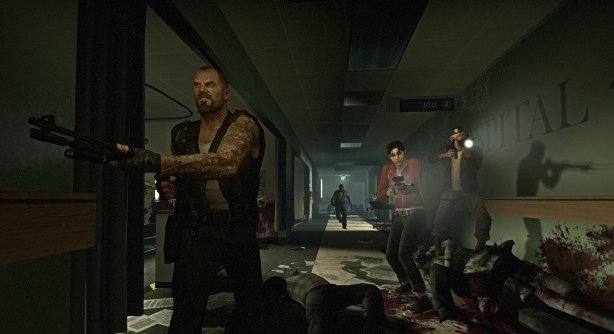
Notice the nice shadows the older guy on the right throws in the picture, and of course, the Zombie rushing up from the rear. When playing the single player game your team’s AI is actually quite good. You’ll find them protecting you, covering different angles, and actually helping you move to the rescue point and safe houses. Unlike a lot of game AI, they follow your lead and manage to stay with you pretty good instead of wandering off or chasing a single Zombie while the horde is attacking. More often than not they form a defensive formation and methodically pick off Zombies, or form a floating formation and move while picking off the Horde.
TESTING & METHODOLOGY
To test Crossfire and SLI with Left 4 Dead we did a fresh load of Vista 64 bit on our Asus P6T Deluxe Core i7 965 Extreme test rig. We applied all the needed patches and updates to bring the OS and drivers up to date with the newest drivers and patches. We deliberately left the video drivers out of the setup, then cloned the Intel 80GB SSD to a normal SATA drive. That way we can load the ATI drivers then when it comes time to switch to Nvidia we can load the SSD from the clone and have a fresh palette with no leftover drivers to interfere with testing.
Both the Crossfire and SLI setups were tested on the same motherboard, the P6T Deluxe, the CPU speed was kept at 3.74GHz, with the Corsair Dominator TC DDR3 6GB speed kept the same. The entire rig, with the exception of switching GPU’s was kept exactly the same, and speeds were kept the same for both sets of GPU’s. So, keep the “it wasn’t a fair test” carping to a minimum. It’s the fairest test possible.
We picked the Diamond 1GB 4870 CF setup because it affords 1GB of memory just like the EVGA GTX-280’s. Both sets of GPU’s are the top single core GPU from each manufacturer. We’d also like to see a lack of “I’d have liked to have seen the 4870X2 in the mix” carping. We’re testing single core GPU’s this round. We’re testing single core Crossfire and single core SLI GPU’s. When Nvidia comes out with their X2 line, then we’ll probably run some dual core vs. dual core. We hear rumors of a GTX-260X2 (GTX-295), so it might not be that far off.
Rather than depend on running a game pattern and using Fraps, we recorded a custom time demo 242 seconds in length. That’s 4 minutes and 2 seconds on level three. We’re leaving out of a safe house and quickly making our way through a mass of Zombies out in the open, moving into structures and wiping out the disgusting creatures there, back into the open and destroying a fence, and after destroying the fence we get swamped by “The Horde”. We turned every eye candy up to maximum, tested with no AA/AF, 4xAA 8xAF, and 8xAA 16xAF, at both 1680×1050 and 1920×1200. We would launch the timedemoand then kick in Fraps with Fraps set to stop the bench after 40 seconds. With Vsync off, the 4 minute 2 second timedemo would run in about 42 seconds. Each test was run a total of three times and the average of those three runs reported here.
GPU Comparison Table
| Major GPU Specifications | ||||||||
| GPU | HD 3870 X2 | 9800 GX2 | Palit 4870X2 | GTX 260 | GTX 260 216 | EVGA GTX 280 | HD 4850 | Diamond 4870 1GB |
| GPU frequency | 825 MHz | 600 MHz | 750 MHz | 576 MHz | 655 MHz | 602 MHz | 625 MHz | 750 MHz |
| ALU frequency | 825 MHz | 1500 MHz | 750 MHz | 1242 MHz | 1404 MHz | 1296 MHz | 625 MHz | 750 MHz |
| Memory frequency | 900 MHz | 1000 MHz | 900 MHz | 999 MHz | 1125 MHz | 1107 MHz | 993MHz | 900MHz |
| Memory bus width | 2×256 bits | 2×256 bits | 2×256 bits | 448 bits | 448 bits | 512 bits | 256 bits | 256 bits |
| Memory type | GDDR3 | GDDR3 | GDDR5 | GDDR3 | GDDR3 | GDDR3 | GDDR3 | GDDR5 |
| Memory quantity | 2 x 512 MB | 2 x 512 MB | 2 x 1024 MB | 896 MB | 896 MB | 1024 MB | 512 MB | 1024 MB |
| Number of ALUs | 640 | 256 | 2×800 | 192 | 216 | 240 | 800 | 800 |
| Number of texture units | 32 | 128 | 80 | 64 | 72 | 80 | 40 | 40 |
| Number of ROPs | 32 | 32 | 32 | 28 | 28 | 32 | 16 | 16 |
| Shading power | 1 TFlop | 1152 GFlops | 2.4 TFlops | 715 GFlops | 824 GFlops | 933 GFlops | 1 TFlop | 1.2 TFlops |
| Memory bandwidth | 115.2 GB/s | 128 GB/s | 115.2 GB/s (x2 | 111.9 GB/s | 126.0 GB/s | 141.7 GB/s | 31.78 GB/s | 115.2 GB/s |
| Number of transistors | 1334 mil | 1010 mil | 956 mil X 2 | 1400 mil | 1400 mil | 1400 mil | 965 mil | 965 mil |
| Process | 55nm | 65nm | 55nm | 65nm | 65nm | 65nm | 55nm | 55nm |
| Die surface area | 2 x 196 mm² | 2 x 324 mm² | 2 x 260 mm² | 576 mm² | 576 mm² | 576 mm² | 260mm² | 260mm² |
| Generation | 2008 | 2008 | 2008 | 2008 | 2008 | 2008 | 2008 | 2008 |
| Shader Model supported | 4.0 | 4.0 | 4.1 | 4.0 | 4.0 | 4.0 | 4.1 | 4.1 |
Test Rig
| Test Rig “Quadzilla” |
|
| Case Type | Top Deck Testing Station |
| CPU | Intel Core I7 965 Extreme (3.74 GHz 1.2975 Vcore) |
| Motherboard | Asus P6T Deluxe (SLI and CrossFire on Demand) |
| Ram | Corsair Dominator TC DDR3 1600 6GB |
| CPU Cooler | Thermalright Ultra 120 RT (Dual 120mm Fans) |
| Hard Drives | Intel 80 GB SSD |
| Optical | Sony DVD R/W |
| GPU’s Tested | EVGA GTX-280 (2) Drivers 180.47 Diamond 4870 1GB Drivers – 8.11 |
| Case Fans | 120mm Fan cooling the mosfet cpu area |
| Docking Stations | None |
| Testing PSU | Thermaltake Toughpower 1200 Watt |
| Legacy | None |
| Mouse | Razer Lachesis |
| Keyboard | Razer Lycosa |
| Gaming Ear Buds |
Razer Moray |
| Speakers | None |
| Any Attempt Copy This System Configuration May Lead to Bankruptcy | |
TEST RESULTS
We’re going to run 1680×1050 with no AA/AF, 4xAA 8xAF and 8xAA 16xAF, then go on to the highest resolution we tested at, which was 1920×1200. We included single GPU results in case you happen to be looking at a single card and then adding one in later.
1680×1050 Results
Running at 1680×1050 No AA/AF, even with single GPU’s running, both the GTX-280 and 4870 1GB are pushing way above the magical 30FPS that makes graphics look rock solid to the eye. You can see from the scaling that the game isn’t particularly well optimized for SLI or Crossfire. Being a DirectX 9 game we didn’t really expect it to be well optimized. Both sets of GPU’s ran the timedemo so fast that you could hardly tell what was going on.
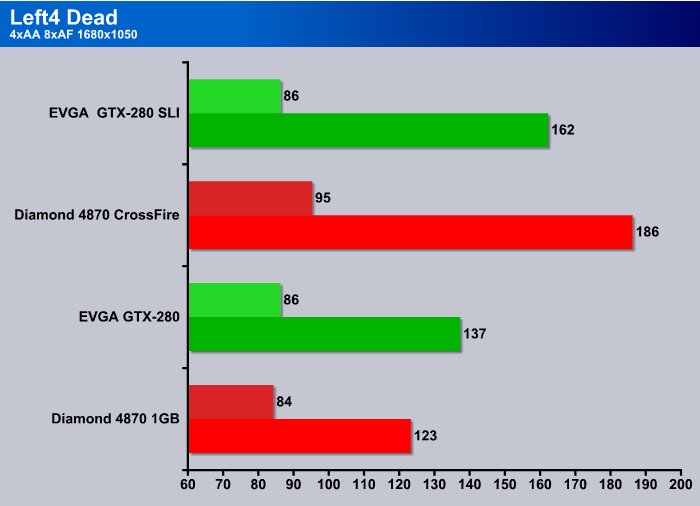
With AA/AF half maxed at 4xAA and 8xAF the single GTX-280 took some lead over the 4870 1 GB, but both cards did amazingly well. Again, we see that Crossfire and SLI get some scaling on Average FPS but not much in the way of Minimum FPS. Crossfire scaled a little better on Minimum FPS at this setting. Once again though, we see that Single or Dual cards of either flavor would make Left 4 Dead graphics nirvana.
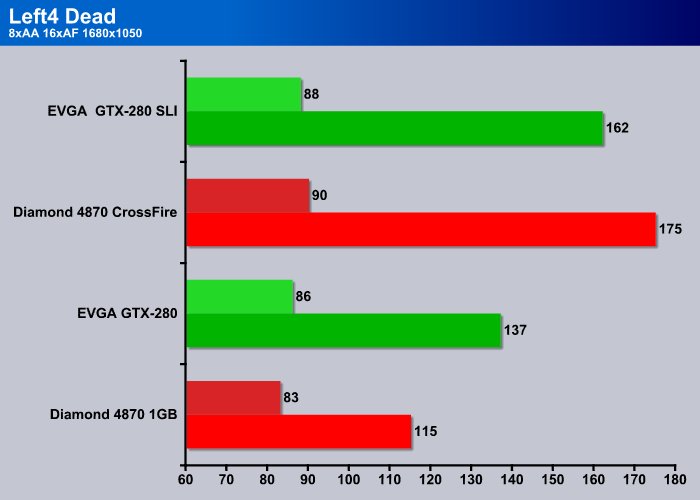
At 1680×1050 with all the eye candy cranked up and 8xAA 16xAF, the single GTX-280 did a little better than the 4870 1GB, but both cards did well enough that you wouldn’t get hurt running either one. Again, we don’t see much gain on Minimum frames when we move to the Dual card tests, but we do see a pretty decent increase in Average FPS. As far as the human eye is concerned, you might as well run a single GPU.
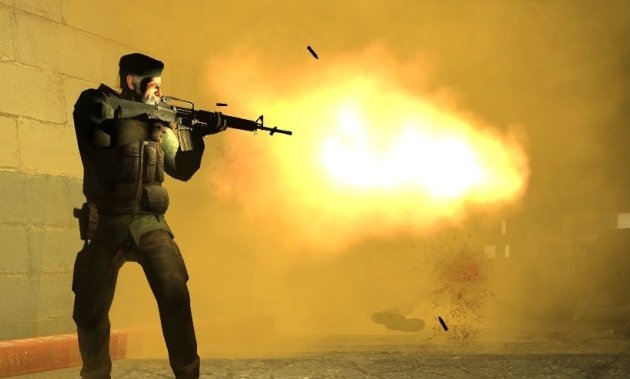
No, that’s not a flame thrower, that’s an M16, and while the muzzle flash is a little unrealistic for what an M16 throws out, it does look pretty sweet. Notice the light increases on the side of the character where the flame from the rifle lights up his face. You also get some nice smoke effects that add to the realism of the game. When you get lucky enough to find a Mini gun mounted, if you fire continuously the smoke cloud will get large enough to obscure your vision, so fire that puppy in bursts.
1920×1200 Results
Moving to the highest resolution tested in single card testing, the Evga GTX-280 comes out a little ahead in minimum, but how can you complain with FPS like that on both cards? Once again, it looks like Crossfire scales a little better in Minimum FPS and in this case in Average FPS as well.
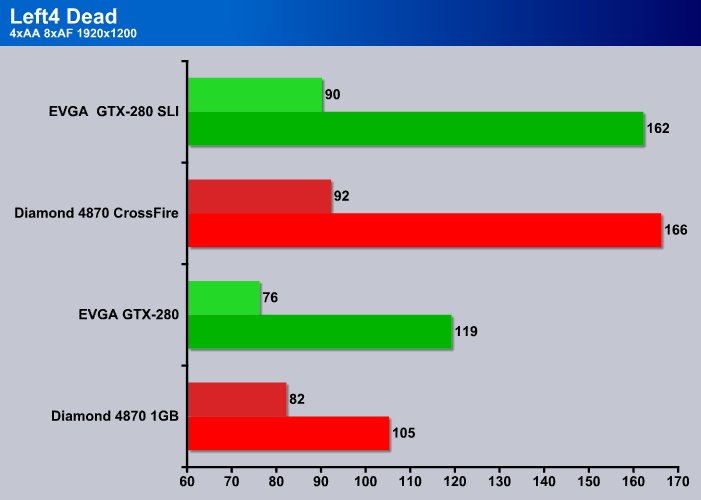
Running 192-x1200 with 4xAA 8XAF Minimum FPS single card, the 4870 1GB came out a little ahead, but the GTX-280 came out on top on the Average FPS test. When we move to SLI and Crossfire, the ATI card pulls out a little ahead but not by enough to be significant. Both single card and dual card setups will still run Left 4 Dead at graphics nirvana levels.

Then at the highest level we tested, at 1920×1200, we still see both single cards running Left 4 Dead at fantastic levels. We do see some advantage when running SLI and Crossfire at this level. With it running so well in single card though, throwing Crossfire and SLI is just putting whipped cream on top the ice cream.
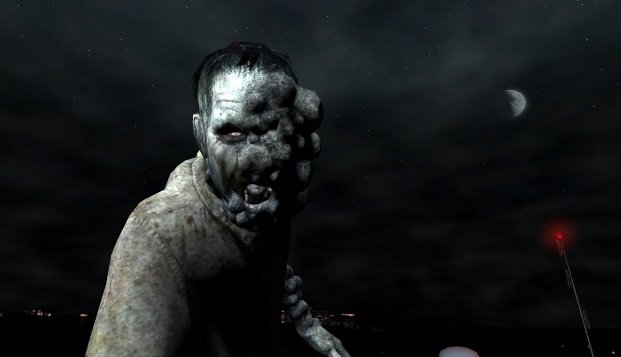
CONCLUSION
Valve decided to go with DirectX 9 when they coded Left 4 Dead, and making that choice and coding it in a highly efficient manner produces fantastic FPS results with both the Single EVGA GTX-280 and Diamond 4870 1 GB. When you move to SLI and Crossfire you see some improvement, but it’s not really an improvement that’s going to make it any better for the human eye.
The game itself is definitely the best FPS horror game we’ve seen in a very long time and it’s shown that it will play equally well on both ATI and Nvidia high end GPU’s. We’d suspect that it will run just fine on mid-range GPU’s like the 4850 and GTX-260.
We’re hoping that this is going to be a trend among game developers, games that will run efficiently with high FPS on a wide range of GPU’s and not requiring us to spend big bucks on a new GPU just to play it.
DirectX 10, while providing a goodly amount of eye candy, just seems to kill the GPU’s when it comes to playable frame rates. With any luck, DirectX 11 will be better optimized, but what we’d really like to see is more games that run with high FPS. It gets a little old having to upgrade GPU’s every year because programmers can’t take the time to optimize code, or just don’t care that it takes a $500 dollar GPU just to play it.
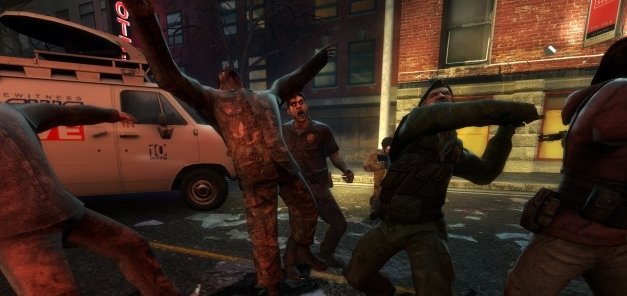
Game play is fast paced if you want it to be, or you can take a slower pace and methodically wipe out every Zombie you see. At least until the horde comes calling. Then, it’s time for some serious spray and pray. Which GPU is better for this game? Both do well enough that there’s nothing to complain about and we’re not rating them in this review. We’re rating the game itself.
Performance wise, FPS were high enough that Nvidia or ATI cards will make for some great graphics nirvana. Game play is fun and highly re-playable because the Zombies and boss creatures never appear in the same places play to play.
Online play with a group of friends is a blast and we’d have to say that the only thing missing from this epic title is you.
 Bjorn3D.com Bjorn3d.com – Satisfying Your Daily Tech Cravings Since 1996
Bjorn3D.com Bjorn3d.com – Satisfying Your Daily Tech Cravings Since 1996

